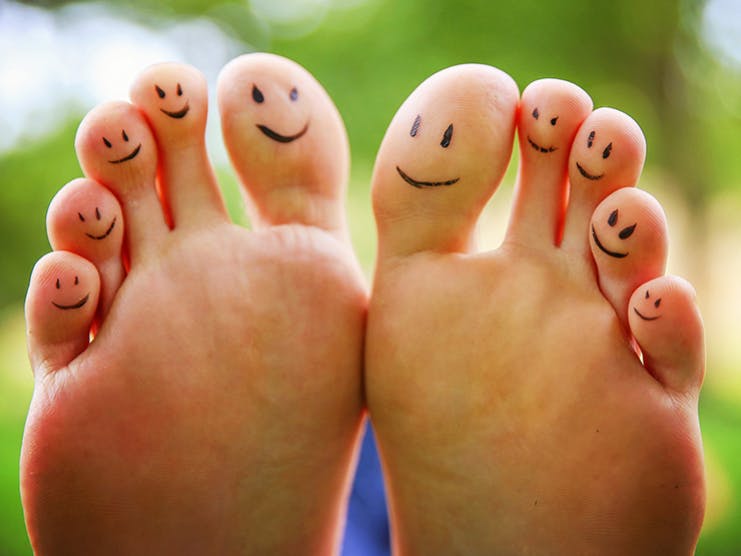
Foot pain becomes more common once we hit our 40s, but you can avoid it with some pretty simple steps.
Got foot pain?
You’re in good company. About a quarter of all folks over the age of 45 experience some type of foot pain, according to a recent review in the American Journal of Medicine. Blame the wear and tear of natural aging, as well as osteoarthritis.
Another big culprit? Unsupportive footwear–and summer flip-flops are the worst.
“Flip-flops have absolutely no support, and the shoe’s design forces your muscles and Achilles tendon to work too hard to keep the flip-flop in place when you walk,” Kaitlin Neary, a foot and ankle orthopedic surgeon said in a recent American Orthopaedic Foot & Ankle Society press release.
Fortunately, there are some easy steps you can take, not only to prevent foot problems, but also to keep your tootsies looking as polished as possible.
Here are some common foot issues and how to treat them.
Plantar fasciitis
What it is: A condition where the plantar fascia, the thin ligament on the bottom of your foot that connects your heel to the front of your foot, becomes irritated and inflamed. It’s common to see it crop up after a summer spent in flip-flops.
What it feels like: Pain on the bottom of your foot near your heel that’s worse after a period of rest, like getting out of bed in the morning. It usually gets better after a couple minutes of walking and may worsen after activity.
Treat it: Ninety percent of people with plantar fasciitis see improvement after ten months with a few simple measures, according to the American Academy of Orthopedic Surgeons.
- Rest
- Ice (roll your foot over a cold water bottle for 20 minutes 3 to 4 times a day)
- Over the counter NSAIDs
- Simple exercises, such as calf stretches
- Supportive footwear, like running shoes
Bunions
What they are: Painful bony bumps that develop at your big toe joint. They’re likely to crop up after years of foot pressure from poor-fitting shoes.
What they feel like: Pain, especially when you’re wearing shoes. You may also notice swelling, redness, and trouble walking due to a stiff big toe.
Treat it: This is one time when wearing open-toed shoes is a good idea. If you need to wear closed-toe ones, make sure they fit correctly: they should be about one-half inch longer than your longest toe, and have a roomy toe box. Other ways to relieve pain:
- Pad it. You can buy OTC “bunion-shield” pads at the drugstore to help cushion sore spots. Just do a test run before heading out for a long day – sometimes the pads can increase pressure on the bump and worsen your pain.
- Orthotics. You can try over-the-counter shoe inserts, or even toe spacers, which are placed between your toes. A night splint that straightens out your big toe can also provide relief.
- Bunion surgery. If the above strategies don’t work, your doctor may recommend surgery. It’s generally a last resort, though, since recovery can take up to six months.
Corns and calluses
What they are: Thickened areas of skin that form on your toes or the soles of your feet as a result of pressure.
What they feel like: Corns are pea sized and are usually painful or tender. They may have a fluid-filled sac underneath them. Calluses are usually painless.
Treat ‘em: Try this mini-pedicure treatment at home to soothe and prettify feet.
- Soak the corn or callus in warm water for five to ten minutes.
- File it down with a pumice stone dipped in warm water, using a circular motion to remove dead skin.
- Trim your toenails. If they’re too long, your toes will push up against your shoe and create a corn. Be careful to trim them straight across, or you could end up with an ingrown toenail.
- Apply a moisturizer with salicylic acid, ammonium lactate, or urea to soften feet. Avoid applying moisturizer between the toes, though, as it can cause an infection.
Neuropathy
What it is: If you have type-2 diabetes, you can develop neuropathy, a complication where you lose foot sensation. This isn’t just annoying: it’s dangerous, since you may not notice if you step on a sharp shell at the beach.
What it feels like: Usually numbness or a tingling, “pins and needles” sensation.
Treat it:
- Don’t walk barefoot. Yes, it’s a ritual of summer, but nerve damage decreases sensation. You won’t notice that little pebble that got stuck in your foot, which can mean a summer stroll can turn into a trip to the ER due to a massive cut or infection. Pad around in shoes or slippers at home, too.
- Wash your feet daily. Besides preventing stinky feet, it also lowers risk of infection, especially important if you have type-2 diabetes. Follow up with lotion, to prevent dry skin cracks that can also become infected.
- Trim your toenails straight across. It helps prevent cutting your skin, and keeps your nails from growing into your skin.
- Keep your feet warm. Wear socks to bed, even in the summer.
- Wiggle your toes frequently. This helps keep blood flow moving in your tootsies.
Learn more about Medicare coverage for diabetes
Athlete’s foot
What it is: A common rite of passage during the summer. You can easily pick up this fungal infection padding around barefoot in moist public places like a pool deck or locker room.
What it feels like: You may notice some itching and burning between your toes. Your skin looks dry and scaly, and you can see inflammation or swelling.
Treat it: The good news is athlete’s foot usually clears up quickly with an over-the-counter antifungal cream like erbinafine (Lamisil) or clotrimazole (Lotrimin). If it doesn’t clear up in a couple weeks, your doctor may want to prescribe oral fungal medicine. You can prevent it from returning by tossing some OTC anti-fungal powder into shoes, and wearing sandals or flip flops in public places like gym showers and pool decks.
Toenail Fungus
What it is: Is there (gasp!) a fungus among us? If you have discolored, thick, or cracked toenails, chances are you have onychomycosis, or a nail fungal infection. About 20% of people over the age of 60, and 50% of those over the age of 70, have one.
What it feels like: Usually painless, but the affected nail turns an ugly shade of white, yellow, or brown.
Treat it: Unfortunately, toenail fungus is hard to get rid of. Topical treatments typically don’t work very well. And oral medications aren’t usually recommended for people over the age of 65 because they can cause liver damage.
The good news is that, while the fungus may look terrible, it’s harmless. Your best bet is to keep the nail clean, trim it frequently, and thin it down by filing it often. You can also apply a moisturizer containing urea to it every day.
Does Medicare cover it?
Medicare Part B will cover annual foot exams and treatment if you have diabetes-related nerve damage or require medically necessary treatment for foot conditions such as bunions or plantar fasciitis. Medically necessary custom inserts and shoes are covered for people with diabetes.
Some Medicare Advantage policies may offer broader coverage, including discounts for some over-the-counter products like night splints and inserts.
Medicare doesn’t cover routine foot care for other common foot conditions such as corns or calluses. Fortunately, these can often be easily treated at home.
Do you have Medicare questions? We have answers
When it comes to Medicare, one plan definitely does not fit all. At ClearMatch, it’s our mission to match you to the policy that best serves your unique needs. It’s all we do, and we do it better than anyone. Check out our extensive library of articles for answers to your Medicare questions. Or, compare plans in your area to get started finding the policy that’s right for you.
Additional Resources
ClearMatch Medicare: Does Medicare Cover Diabetes?
Internal Website Link
ClearMatch Medicare: Find a Plan
Internal Website Link
American Orthopaedic Foot and Ankle Society: “Jump Into Summer Free From Foot Pain”
External Website Link
American Academy of Orthopedic Surgeons: “Plantar Fasciitis”
External Website Link
American Academy of Orthopedic Surgeons: “Bunions”
External Website Link
American Academy of Dermatology: “How to Treat Corns & Calluses”
External Website Link
American Academy of Dermatology: “Nail Fungus: Diagnosis & Treatment”
External Website Link
American Journal of Medicine: “Foot Examination for Older Adults”
External Website Link


